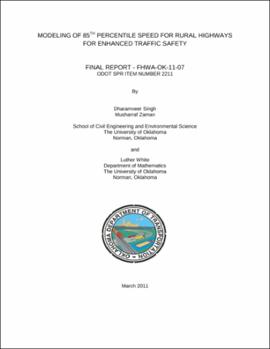| dc.description.abstract | Traffic operation on two-lane rural highways and setting posted speed limits are some of the difficult tasks faced by the Oklahoma Department of Transportation (ODOT) and other transportation agencies. The present study was undertaken to develop artificial neural network (ANN) models to predict 85th percentile speed (V85) of two-lane rural highways in Oklahoma. Several input parameters, namely, roadway characteristics, traffic conditions, and accident experience were considered in developing the ANN models. Physical characteristics of road include, surface width (SW), shoulder type (ST), and shoulder width (SHW). Traffic parameters cover average daily traffic (ADT), posted speed (PS), and V85. Pavement condition includes skid number (SN), and international roughness index (IRI). The location collision rate, statewide collision rate (overall, fatal, and injury), and percentage unsafe speed drivers (USD) were covered in the accident data.
Data from a total of 241 two-lane rural highway sites were collected and used in developing the ANN models. The following four different ANN models were developed: Model 1 includes Posted Speed but does not include Accident Data; Model 2 includes neither Posted Speed nor Accident Data; Model 3 includes both Posted Speed and Accident Data; and Model 4 does not include Posted Speed but includes Accident Data. Model 1 included physical characteristics of road, and traffic parameters including PS, while Model 2 covered all the parameters included in Model 1 except PS. Similarly, Model 3 considered accident data with all the parameters included in Model 1. Model 4 used all the parameters included in Model 3 excluding PS. The developed models provided an overall accuracy of more than 90%. For example, Model 1 and Model 2 developed without accident data gave an overall accuracy of 97%, and 91.5%, respectively. Similarly, Model 3 and Model 4 developed using accident data resulted in an overall accuracy of 97.5%, and 94.1%, respectively. It was found that inclusion of accident data improves the performance of the model only marginally.
The present study was pursued with the goal that ANN models for V85 would provide a cost effective alternative for estimating site-specific V85 of two-lane rural highways in Oklahoma. Also, the developed models are expected to be useful for prediction of V85 when roadway characteristics and/or traffic operational factors change. | |
